To stay updated with woodworking trends and innovations, actively explore eco-friendly materials like FSC or reclaimed wood, and adopt advanced tools such as CNC machines for precision. Engage with online communities and industry events to learn about modern design styles and new finishes. Follow the latest market shifts and regulatory changes to keep your work sustainable and competitive. Keep an eye on emerging technologies and creative ideas—you’ll discover more ways to elevate your craft as you continue exploring.
Key Takeaways
- Attend industry events, trade shows, and workshops to learn about the latest woodworking trends and innovations.
- Engage with online communities, forums, and digital platforms to share ideas and stay informed about new techniques.
- Follow industry influencers, blogs, and social media channels focused on woodworking advancements.
- Utilize digital tools like CAD/CAM software and smart manufacturing for up-to-date design and production methods.
- Keep abreast of regulatory and market shifts, such as sustainable material certifications and eco-friendly practices.
Embracing Sustainable Material Sourcing and Eco-Friendly Practices
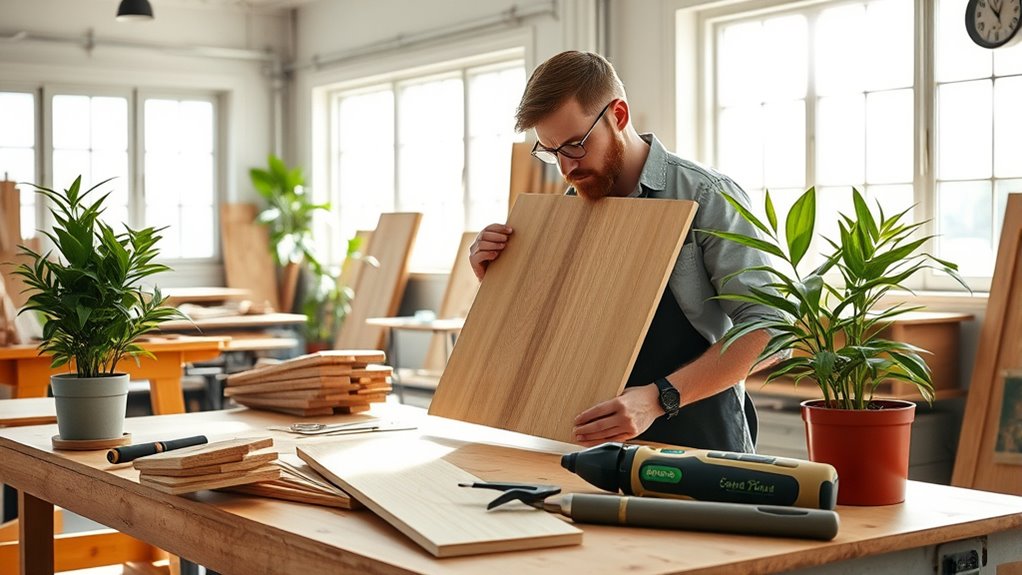
Embracing sustainable material sourcing and eco-friendly practices allows woodworkers to create beautiful projects while minimizing environmental impact. By choosing FSC-certified wood, you guarantee your materials come from responsibly managed forests that protect biodiversity and local communities.
Using PEFC-certified wood further assures sustainable forest management worldwide. Incorporating reclaimed or recycled wood reduces demand for virgin timber and cuts waste. Additionally, selecting renewable wood sources helps ensure your projects support sustainable harvesting practices that do not deplete natural resources.
Supporting local suppliers and eco-conscious brands decreases transportation emissions and boosts regional economies. Opting for fast-growing, renewable species instead of slow-growing hardwoods enhances sustainability. Promoting active listening and empathy within the sourcing process can foster stronger relationships with suppliers and communities, ensuring ethical practices are maintained.
In addition, selecting sustainable material sourcing options can help reduce the overall carbon footprint of your woodworking projects. Conducting lifecycle assessments of materials provides a comprehensive understanding of their environmental impact, guiding better choices. Recognizing the importance of forest conservation ensures your work aligns with efforts to preserve natural habitats for future generations. These practices not only promote forest health but also demonstrate your commitment to ethical craftsmanship.
Sustainable sourcing aligns your work with environmental stewardship, making your projects both beautiful and responsible.
Leveraging Advanced Technologies for Precision and Customization
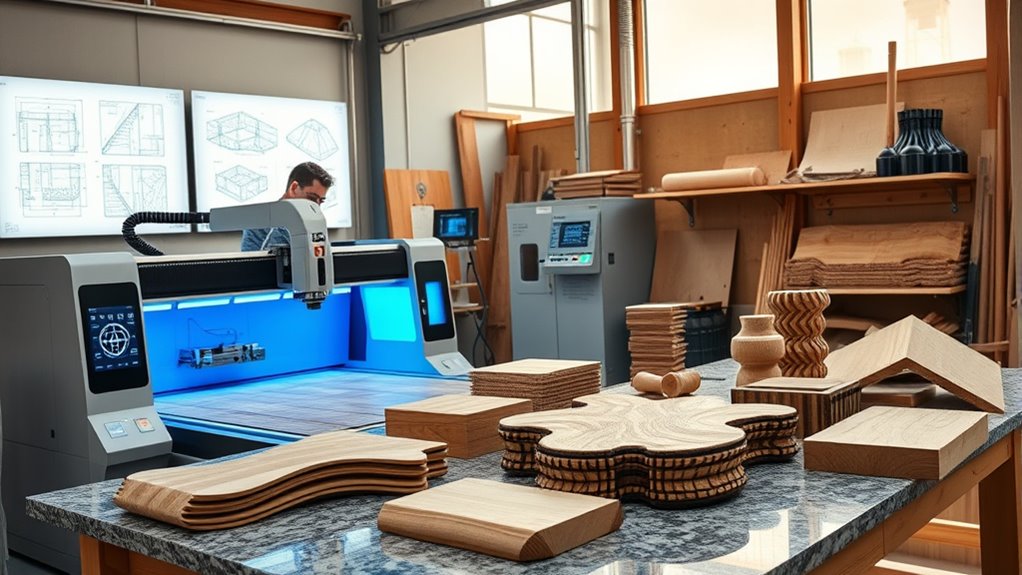
Advances in woodworking technology are transforming how projects are designed and produced, offering new levels of precision and customization. CNC machines automate cutting, carving, and shaping with computer-guided tools, delivering millimeter-level accuracy that minimizes errors and waste.
They enable the creation of intricate patterns, joints, and inlays efficiently, reducing production time and increasing output. CNC technology also guarantees consistency across multiple pieces, vital for mass production and matching components. Automation in woodworking improves efficiency and allows for more complex designs that were previously difficult or impossible to execute manually. Moreover, integrating performance kits similar to automotive upgrades can optimize machine operation and extend equipment lifespan.
Additionally, these machines work with various materials, including hardwoods, softwoods, and composites, expanding your design options. Material versatility broadens creative possibilities and enables tailored solutions for diverse projects. Laser cutting and engraving further enhance detail work, allowing for high-precision decorative and functional features.
Integrating CAD/CAM software streamlines the workflow, making customization faster and more accurate, all while elevating the quality of your craftsmanship. Recognizing the role of precision in woodworking can help you achieve professional results with greater efficiency.
Incorporating Modern Design Trends for Functional and Aesthetic Appeal
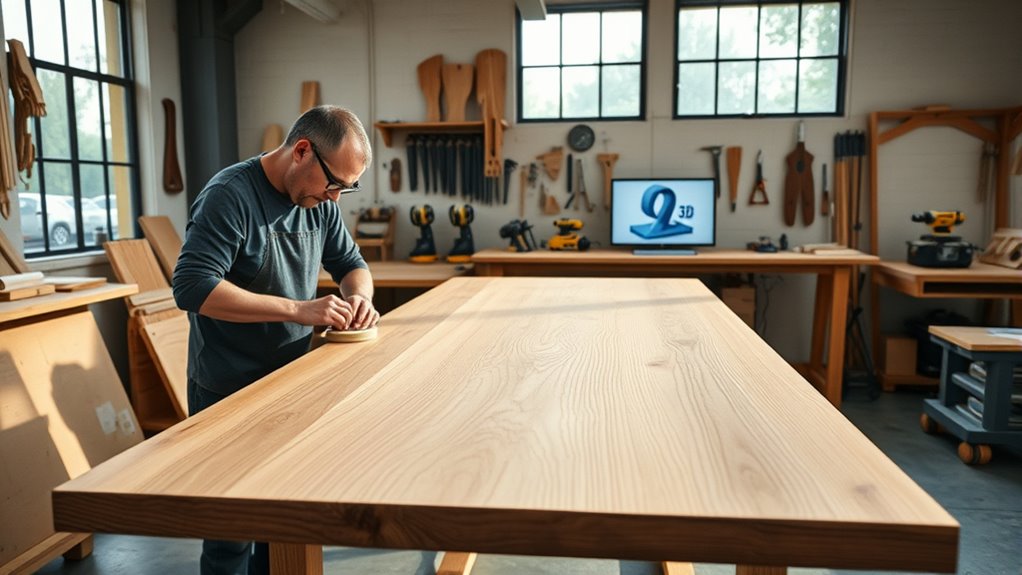
Have you noticed how modern woodworking designs seamlessly blend style and function to create spaces that are both beautiful and practical? Today’s trends emphasize sustainability, using eco-friendly finishes and reclaimed wood to reduce waste and reflect client values. Incorporating natural elements such as live-edge slabs and organic textures not only enhances visual interest but also fosters a sense of connection to nature. Additionally, integrating biophilic design principles helps bring the outdoors inside, creating more inviting and health-promoting environments. Embracing innovative materials like recycled composites further supports eco-conscious design choices. Incorporating biophilic design brings nature inside, highlighting natural materials like knots and grain patterns that add character and connection to the environment. Modern aesthetics also favor minimalism, curved silhouettes, bold color accents, and mixed materials for a fresh, versatile look. Incorporating sustainable practices such as using eco-friendly finishes and reclaimed wood supports environmentally responsible craftsmanship. Incorporating timeless design principles ensures that furniture remains stylish and relevant over time, blending tradition with innovation. Functionality is boosted with smart furniture, integrated lighting, and ergonomic features that enhance daily use. By balancing traditional craftsmanship with innovative techniques and materials, you can craft unique, durable pieces that are both visually striking and highly functional, meeting the needs of today’s eco-conscious and design-savvy clients.
Utilizing Innovative Finishes and Alternative Materials
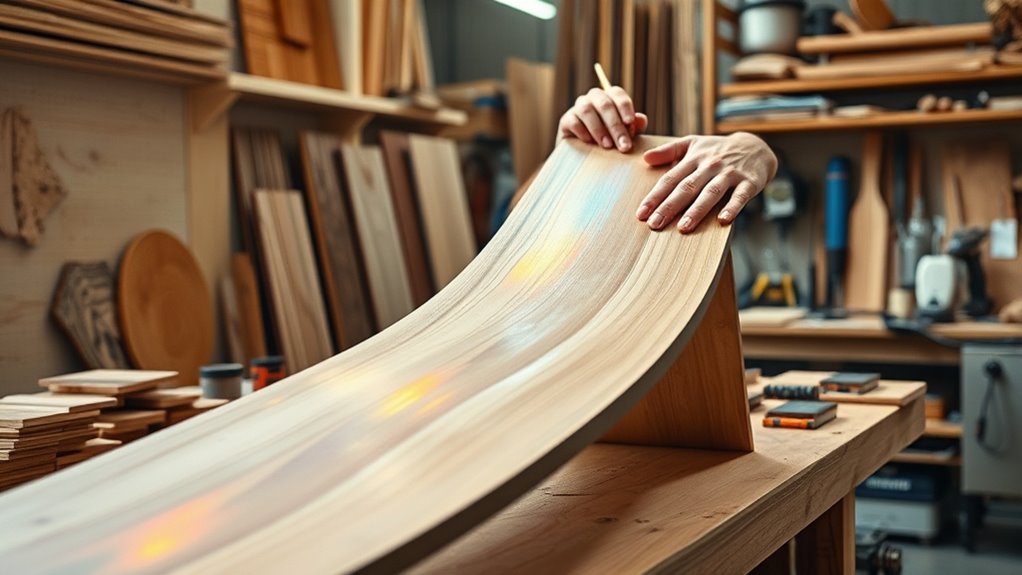
Are you exploring how innovative finishes and alternative materials can elevate your woodworking projects? Modern finishes like textured techniques—wire-bushing, sandblasting, and hand-scraping—add tactile depth, highlighting natural grain and knots. These finishes hide scratches, making them perfect for high-traffic areas, while supporting sustainability with reclaimed or responsibly sourced wood. Incorporating digital platforms for collaboration can help you learn new finishing techniques and share ideas with a broader community. Natural matte finishes emphasize raw beauty, aligning with 2024 trends away from gloss. Bold colors, like deep blues and rich greens, create statement pieces, while weathered looks evoke coastal serenity. Eco-friendly options, including low-VOC finishes and natural oils, grow in popularity. Additionally, understanding sustainable wood sourcing ensures your projects remain environmentally responsible and compliant with current standards. Advances in eco-conscious materials such as engineered woods, bamboo, and composites expand creative possibilities. Meanwhile, new materials such as resin, metal accents, engineered woods, bamboo, and composites expand creative possibilities. Advances like nano-coatings and smart finishes further enhance durability and ease of application, helping you craft innovative, sustainable projects. Incorporating attention to detail in your finishing techniques can significantly enhance the perceived quality and longevity of your work. Exploring digital media and online tutorials can also accelerate your skill development and inspire new ideas.
Staying Connected Through Online Communities and Industry Events
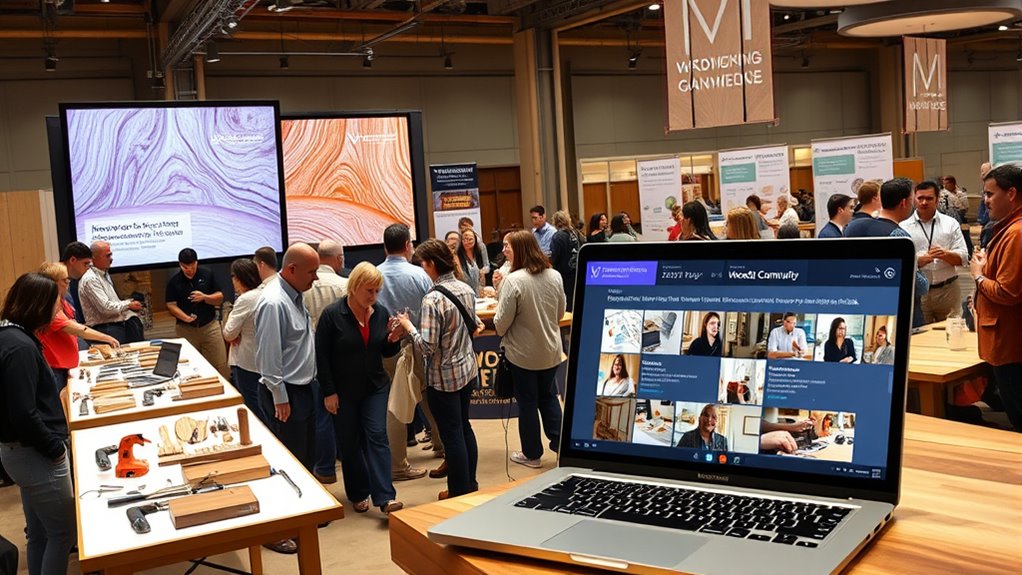
Connecting with the woodworking community has never been easier thanks to online platforms and industry events. Social media sites like Instagram and YouTube let you showcase projects and learn from others effortlessly. Engaging in forums such as Reddit or specialized woodworking communities helps you exchange ideas and troubleshoot. Attending trade shows, workshops, and conferences keeps you updated on the latest trends and tools while offering valuable networking opportunities. Local meetups and product launches further expand your connections. Digital tools like social media management apps and online directories make staying active and visible simpler. Sharing your work, responding to feedback, and collaborating on projects strengthen your presence. Staying informed about industry innovations and new woodworking techniques ensures you remain competitive and inspired. Being aware of affiliate marketing disclosures and privacy policies helps you understand how online platforms manage your data and support transparency. Participating in these events and communities ensures you stay informed, inspired, and connected within the woodworking world.
Aligning Business Strategies With Market and Regulatory Trends
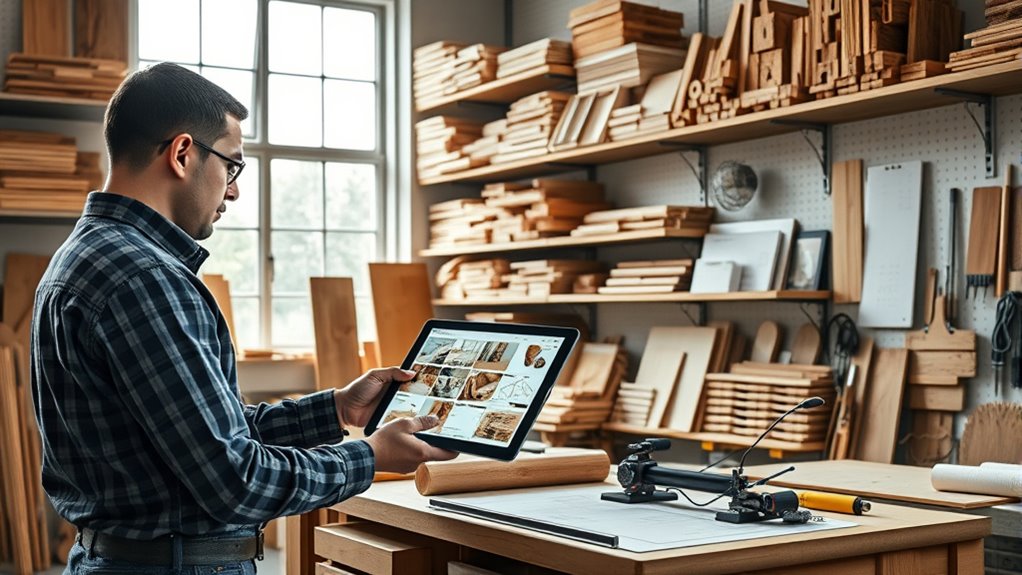
To stay competitive in the evolving woodworking industry, aligning your business strategies with current market and regulatory trends is essential. The market is projected to grow from $31.57 billion in 2024 to $34.22 billion in 2025, driven by increased demand for sustainable materials and custom home renovations.
Stay ahead by adopting eco-friendly products like laminated timber and CLT, and prioritize certified wood to meet rising consumer expectations. Be prepared for trade policy shifts, such as tariffs and protectionist measures, which could disrupt your supply chain and increase costs.
Developing agile supply strategies and investing in digital tools—like cloud-based collaboration and smart manufacturing software—can boost efficiency and resilience. By aligning your operations with these trends, you’ll position your business for sustainable growth in a dynamic marketplace.
Frequently Asked Questions
How Can Small Woodworking Businesses Adopt Sustainable Practices Effectively?
To adopt sustainable practices effectively, you should prioritize sourcing FSC-certified or reclaimed wood, reducing waste through optimized cuts and repurposing scrap, and using energy-efficient tools. Incorporate eco-friendly finishes like water-based paints and natural oils, and manage chemicals carefully. Partner with local suppliers, share tools via co-ops, and consider renewable energy sources. These steps help you run an environmentally responsible business while minimizing costs and environmental impact.
What Are the Best Tools for Integrating Digital Design Into Woodworking Projects?
You should explore digital design tools like SketchUp and SketchList 3D for creating detailed 3D models, helping you visualize projects and reduce errors.
Use FreeCAD for customizable parametric designs and Crafty Amigo for quick web-based sketches.
Incorporate collaboration and cost calculation features to streamline planning.
These tools boost efficiency, accuracy, and communication, making your woodworking projects more precise and easier to manage from concept to completion.
How Do Modern Trends Influence Traditional Woodworking Craftsmanship?
Modern trends profoundly influence traditional woodworking craftsmanship by blending classic techniques with innovative designs. You incorporate bold colors, patterns, and natural motifs to create visually striking pieces.
Using fusion of materials like glass or metal adds a contemporary touch. You also embrace customization, working closely with clients to craft personalized furniture.
This approach keeps craftsmanship fresh, relevant, and aligned with current aesthetic and functional preferences while honoring traditional skills.
Which Eco-Friendly Finishes Are Safest for Indoor Air Quality?
Imagine a gust of crisp forest air filling your space—that’s what eco-friendly finishes aim for. You can choose water-based finishes, natural oils like tung or walnut, or beeswax coatings, all low in VOCs. These options improve indoor air quality, reduce health risks, and are safer for your family.
Plus, certifications like Greenguard help ensure you’re selecting the cleanest, most sustainable products for your woodworking projects.
How Can Woodworkers Stay Updated With the Latest Industry Innovations?
To stay updated with the latest industry innovations, you should actively participate in industry events like conferences, expos, and local workshops.
Use digital platforms such as industry magazines, online forums, blogs, and YouTube channels to keep informed.
Engage with professional networks, join associations, and explore collaborative projects.
These actions help you discover new tools, techniques, and materials, ensuring you stay ahead in the woodworking industry.
Conclusion
By staying ahead of woodworking trends and innovations, you’ll transform your craft into something truly extraordinary—like shaping the future with your own hands. Embrace sustainable materials, harness cutting-edge tech, and connect with industry insiders to keep your skills sharp and your designs fresh. The woodworking world is evolving faster than you can imagine, so immerse yourself now and lead the charge—your next masterpiece awaits just beyond the horizon.








